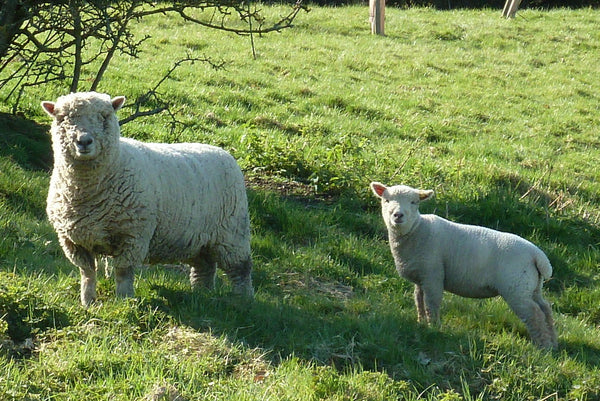Know Your Fiber: Southdown Wool
Posted on September 01 2019

Friendly and easy to manage, the broad-backed and adorable Southdown sheep are a heritage breed of sheep that originated in southern England. These short-wooled sheep have been regaining their popularity over the past couple decades with single-breed heritage fiber fans for their soft, springy wool with a spiral crimp.
Kept by the farmers and shepherds on the chalk hills of what is today known as the South Downs of Sussex, England, the ancestors of Southdown sheep are thought to have populated the area long before the arrival of Romans to the British Isles. The first written references of sheep on the South Downs are found during the medieval era. During this period, livestock developed mostly in isolation from other populations. The sheep on the South Downs developed a tight, short fleece and a compact body well suited to the hills, pastures, and weather of this area. They were allowed to roam freely during the day, but they were frequently herded together at night in a small area on the fields so that their manure could help to enrich the chalk soil.
While Robert Bakewell is well known for developing several of the long-wooled sheep that England is known for, John Ellman is only slightly less well-known among agricultural historians for focusing on the short-wooled Southdowns. Ellman came from a farming family that grew wheat and kept land for livestock grazing. He had little formal education as a child – his father thought it was better that his time be spent learning how to work the land. However, private lessons later in life with the vicar who would become his father-in-law improved his reading and writing, skills he used to a high degree as he began to develop and promote his improved Southdown sheep.
Ellman began improving the Southdown in the late 1700s. The Southdowns were well regarded for their wool – for the time it was considered to be quite fine -- but not so much for their meat. Given that the trend of the late 1700s was for sheep that could be raised for both good wool and good meat, some found the Southdowns rather lacking. The first Secretary to the Board of Agriculture, Arthur Young, wrote rather disparagingly of the unimproved Southdowns in 1776 saying that, “Fine wool is certainly a very considerable object, provided it is gained on a well-formed carcase; but if a fine coat is procured at the expense of a thin chin, low fore-end, and rising back-bone, the advantage is purchased too dearly.” However, his opinion would change by 1788 when he returned to the area and declared of Ellman’s improved Southdowns that, “The wool is the finest in England… the mutton has no superior.”
All this improvement was done by only breeding Southdowns with Southdowns – no other breed was used, making Southdown one of the few thoroughbred English sheep. When Young returned to examine Ellman’s flock in 1794, he praised their constitution, wool, and mutton, declaring that Ellman’s flock was, “unquestionably the first in the county. There is nothing that can be compared with it; the wool the finest, and the carcase the best proportioned.”
Ellman was not stingy with his breeding discoveries and enthusiastically shared them with all who wanted to know more. As a result, be became a popular spokesman and procurer for the breed. He found himself and his sheep becoming quite popular among the wealthy and the nobility of his own country, as well as the nobility of other countries – the Emperor of Russia requested a pair of Ellman’s rams through King George III. Ellman met King George III himself the following year in 1799, and was gifted Merinos from the king’s own flock. However, once he found that he could fatten three Southdowns on the same feed that would fatten only one Merino, he gave up raising the Merinos. If he couldn’t use his sheep for both wool and mutton, he simply wasn’t interested.
Although Merinos continued to gain ground during the early 1800s as the preferred fine wool by many, Southdown was a close second. Many considered Southdown to be the English fleece closet to Merino in fineness. As a result, Southdown was a very popular wool for clothing. Their wool was integral to what may have been the first ever recorded sheep-to-sweater type of exhibition. In 1811, Sir John Throckmorton place a bet of 1,000 guineas that he could have dinner in the evening dressed in a suit made from wool shorn from Southdown sheep in the morning. He won his bet, with the cloth for the suit having been shorn, washed, spun, woven and dyed (the color was referred to as “damson-colored”) by 4:00 pm, sewn by 10 tailors, and ready for Throckmorton to wear to dinner at 6:20pm.
The renowned John Ellman, tireless promoter and improver of the Southdown breed, retired in 1829 and died in 1832. Additional improvements to the Southdown continued throughout the 1800s by others who continued improving the breed. The resulting sheep today are one of the few improved English sheep breeds from the 1700-1800s that were not improved by adding other breeds to the mix. However, although Southdowns would not receive genetic material from other breeds, they did go on to be bred into other lines, including the Oxford Down and Suffolk.
Most historians think that the Southdowns probably first made their way to North America along with English settlers arriving in 1609 as a part of the Jamestown settlement. We know for certain, though, that first Southdowns from Ellman’s flocks made their way to the United States in 1824 and 1829. By the late 1800s and early 1900s, Southdowns were popular enough that they were being exported all over the world to places like New Zealand, Australia, and many other nations. Their numbers were high until WWI, which saw a reduction in the Southdown sheep population in the U.K. by nearly half. The land available for sheep had already become significantly reduced by this time as cities and towns grew in size, and bigger sheep with bigger carcasses were largely preferred and more profitable. The Southdowns had high quality wool and meat, but they were small, and during the WWI quantity was favored over quality. During WWII the Southdown flocks of the U.K. were reduced even further as the downs on which they grazed were taken over for tank training. Additionally, as in WWI, the demand for wool and meat was for quantity over quality. By 1945 there were only 10,000 breeding ewes left.
After WWII, the number people willing to labor on country farms declined as increased wages for non-farm positions brought more people into the cities. To compensate, many commercial farms continued to seek out larger sheep breeds that could produce more meat and more wool than the Southdowns. The breed continued to decline over the next several decades, and by 1982 there were only 1500 breeding ewes left. However, since then the breed has seen a renewed interest by small farmers and hobbyists – today there are upwards of 10,000 Southdown sheep globally which has placed them on the Recovering list on The Livestock Conservancy’s list of heritage sheep breeds. Due to its docile nature and quality wool, the Southdown has also become an increasingly popular sheep for 4-H shepherds in the United States; a trip to your local county fair during the summer months will likely introduce you to several young Southdown shepherds and their sheep who live in your area.
Heritage breed aficionados should take note: the Babydoll Southdown that has become quite popular as a sheep on hobby farms for its smallness and adorable teddy-bear face is different than the Southdown sheep listed as a heritage breed by the Livestock Conservancy. Babydoll Southdowns were developed from Southdowns in the 1990s by breeders looking for a small and friendly fleece sheep for hobby farmers. Although their wool is also quite lovely, they have different conformation standards than Southdown sheep.
The wool on the face and legs of the Southdown is typically a very light brown, but rest of their fleece is a creamy white – it is this wool that you will find commercially available for spinning. It is a medium weight, shorter wool with a staple length between 1.5-3 inches and a fiber width between 23-30 microns. Like all wool, Southdown can be felted, however felters will find that it may be slightly more difficult to felt; this quality is thought to be due to its spiral crimp. This is, of course, be a boon for those who are interested in spinning yarn for socks or other clothing that might see hard wear. The wool is quite springy with a low-luster that takes up dye very well. But don’t take our word for it – try it out yourself. Check out our Southdown top in our store and online!

Follow US